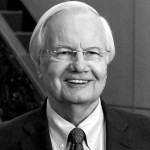
Belgian Jewish star. (Photo by DRG-fan, Wikimedia Commons | CC BY-SA 4.0)
To get to the core of race in America today, read this new book by James Whitman. Whitman is the Ford Foundation Professor of Comparative and Foreign Law at Yale Law School. Prepare to be as startled as this respected legal scholar was when he came upon a meticulous record of a meeting of top lawyers in Nazi Germany after Hitler’s rise to power. Not only did those lawyers reveal a deep interest in American race policies, the most radical of them were eager advocates of using American law as a model. Scholars and historians have argued for years about whether American’s own regime of racial oppression in any way inspired the Nazis. Not only does Whitman throw a bright light on the debate, to this reader he settles it once and for all. Carefully written and tightly reasoned, backed up every step of the way with considered evidence and logic, Whitman reminds us that today is yesterday’s child, and that certain strains of DNA persist from one generation to another.
—Bill Moyers
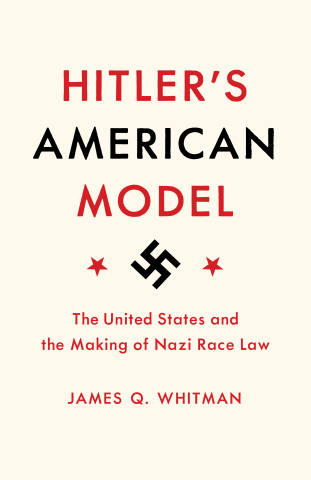
Bill Moyers: You begin the book with a meeting of Nazi Germany’s leading lawyers on June 5, 1934, which happens, coincidentally, to be the day I was born.
James Whitman: Oh boy, you were born under a dark star.
Moyers: To be sure. Adolf Hitler had been chancellor of the Reich for a year and a half. Nazis were rapidly consolidating their hold over Germany. And this was no gathering of everyday, garden-variety lawyers..
Whitman: No, it wasn’t. It was chaired by Hitler’s minister of justice and attended by the leading figures among Nazi lawyers.
Moyers: Why had they gathered? What was their mission?
Whitman: They were there to begin crafting what would eventually become the notorious Nuremberg Laws, which were promulgated a little bit more than a year later, in September of 1935. Those laws would be the culmination of the first phase of the Nazi program of persecution directed against German Jewry. And they were there to respond to the demands of radical Nazis for the creation of a new kind of race state in Germany.
Moyers: And the Nuremberg Laws would embody the full-scale creation of a racist state.
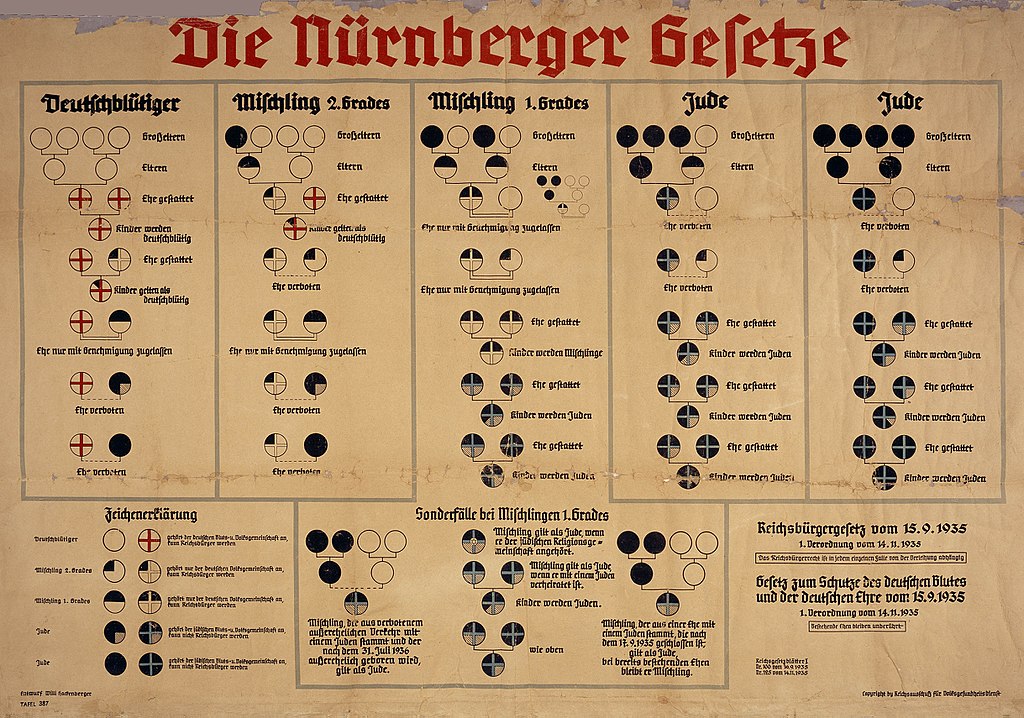
The Nuremberg Laws, 1935. (Image courtesy of Wikimedia Commons)
Whitman: You bet. They did. And that’s how we remember them today.
Moyers: A stenographer was present to record a verbatim transcript of that meeting. Reading that transcript you discovered a startling fact.
Whitman: Yes — the fact is that they began by discussing American law. The minister of justice presented a memorandum on American race law that included a great deal of detailed discussion of the laws of American states. American law continued to be a principle topic throughout that meeting and beyond. It’s also a startling fact that the most radical lawyers in that meeting — the most vicious among the lawyers present — were the most enthusiastic for the American example.
Moyers: And the laws they were creating —
Whitman: There were three Nuremberg Laws eventually promulgated in 1935. The two that most concern us are usually called the citizenship law and the blood law. The citizenship law reduced Jews to second-class citizenship status in Germany. The blood law banned, and in fact criminalized, interracial marriage and sex. But there was a third as well, which was called the flag law for the Reich, the purpose of which was to install the swastika as the exclusive flag of Germany.
Moyers: What were they interested in learning about American law?
Whitman: American law, hard though it might be for us to accept it now, was a model for everybody in the early 20th century who was interested in creating a race-based order or race state. America was the leader in a whole variety of realms in racist law in the first part of that century. Some of this involved American immigration law, which was designed to exclude so-called “undesirable races” from immigration. In 1924 American immigration law in particular was praised by Hitler himself, in his book Mein Kampf.

Polish woman and her nine children at Ellis Island. (Photo courtesy of Ellis Island Immigration Museum)
But it wasn’t just about American immigration law. There was also American law creating forms of second-class citizenship — for African-Americans, of course, but also for other populations including Asians, Native Americans, Filipinos and Puerto Ricans. Not least, there were statutes in 30 American states forbidding and sometimes criminalizing interracial marriage. Those were of special interest to the Nazis.
Moyers: And these lawyers saw America’s “Negro problem” as similar to their “Jewish problem?”
Whitman: You bet they did.
Moyers: American law did not specifically target Jews, but—
Whitman: But it certainly had a highly developed body of law targeting other groups. And the Nazis, although it is true they were unhappy with the lack of American interest in targeting Jews and deplored some aspects of American society, were quite interested in learning from what Americans did in targeting these other populations.
Moyers: The Nazis believed American blacks were multiplying so significantly they would eventually overwhelm the US. There are photographs in your book from a Nazi magazine with images of American blacks at the time, and the caption reads: “The Negros are multiplying significantly more strongly than the white population of the United States. Their constantly growing numbers are a source of great concern to American statesmen.”
Whitman: It’s certainly the case that there were American statesmen, if you want to call them that, especially in the South, who were concerned about the birthrate in the black population. And it’s certainly the case that the Nazis, when they encountered American uneasiness of that kind with regard to the black population, were seeing concerns akin to their own.
Moyers: And that same Nazi magazine showed pictures of the world champion American boxer Jack Johnson, who was not permitted to return to the US because he had married a white woman in Paris. The caption reads, “Mixed marriage between white and black are forbidden in most states of the union.” This ban appealed to the Nazis, didn’t it?
Whitman: It sure did. It was one of the great demands of the Nazis — and again, especially of the radical Nazis — that interracial marriage should be not only prohibited, but criminalized. When they looked for models around the world for the criminalization of interracial marriage, though, they only found one example — well, really 30, because there were 30 American states with anti-miscegenation statutes. And it was to these statues that the Nazi lawyers turned.
Moyers: I was taken with the revelation that to these German lawyers, American blacks “were not a desperately oppressed and impoverished people, but a menacing alien race of invaders that threatened to get the upper hand and therefore had to be thwarted.” There were Americans who believed the same thing in that regard as those German lawyers believed — that blacks were a threat to white rule. Still are.
Whitman: They sure did. Of course, this is the idea and the background of the notorious film Birth of a Nation, screened, as we all know, by President Wilson in the White House. What an awful thought! There were believers in this bizarre interpretation of the American race situation all over the country. Not just in the South, but in places like Columbia University. It was commonplace [for people to think] that America was threatened by this kind of takeover.
Moyers: You quote the German writer Wahrhold Drascher, whose book was titled Supremacy of the White Race: “Americans took care to guarantee that the decisive positions in the leadership of the state would be kept in the hands of Anglo-Saxons alone.”
Whitman: Yeah, that’s what he said. And the Nazis, in their interpretation of the American theme, thought that they were seeing concerns parallel to their own in Germany. What they were worried about in the early stages was precisely that Jews might take over Germany, so the Jews had to be kept out of government, out of the legal profession, and out of any other situation in which they might exercise what the Nazis always called influence. The Nazis used exactly the same language in discussing the situation of American blacks.
Moyers: You quote one prominent Nazi lawyer who admired the Democratic Party of the South for using “racist election law” to build a one-party system.
Whitman: Yes. And the Nazis weren’t the only ones to notice this. Other observers too, including much more palatable ones, looked at the South and saw what they thought was the creation of a one-party system very similar to what was emerging in fascist Europe.
Moyers: So what did those German lawyers meeting in 1934 see when they looked at America in the early 1930s?
Whitman: It has to be said that there was a kinship when it came to the writing of racist laws. There was especially, but not exclusively in the South, a tremendous interest among American legislators and American judges in guaranteeing what was sometimes called the Anglo-Saxon or white character of the country at the time. And American lawyers were quite ingenious, as American lawyers often are, in devising law that was intended to serve that end. The first thing that the Nazi lawyers saw to admire was precisely that ingeniousness, that innovativeness of American law, that willingness to look beyond the traditions of equality that we find in the law for new solutions to guarantee what they regarded as the proper racial purity of the United States.
There were many other currents, some very admirable currents that are still with us in the United States, that the Nazis saw and deplored. They were sort of mystified at how a country so clearly dedicated to white supremacy could also [have] something like the 14th Amendment to the Constitution, which guarantees equal rights to American citizens — among whom, [after] the Civil War, were to be counted the freed black people of the South.
Moyers: And how did the Nazi lawyers square that with their admiration 50 years later of American racist laws?
Whitman: Well, many of them said exactly what American observers still say today, what political scientists will say today — that there were two competing currents in American law: on the one hand, a commitment to universal equality, but on the other hand, a deeply racist tradition, which the Nazis often called the realistic racism of the United States. They liked to think of themselves as realists and they admired the realist racism of the United States too.
Moyers: The racism that existed and was practiced irrespective of law.
Whitman: That’s it exactly. Realism from their point of view meant grappling not only with the world, with the real problems of the world as they presented themselves, rather than formalistic legal abstractions, but also giving effect to the deeply rooted, intuitive racism of the American population in general.
Moyers: So what those Nazi lawyers creating the Nuremberg Laws saw and admired was the United States going about the political construction of race. Americans were using politics to shape laws that would result in a political system organized around race, despite the absence of any meaningful scientific definition of race.
Whitman: That’s it exactly. And of course the problem that they faced involved precisely the difficulty in finding meaningful, reliable scientific definition according to which you could determine who belonged to which race. There were some moderate Nazis involved in the meeting on June 5 who claimed that you couldn’t have criminal statutes targeting Jews because it was impossible to define who counted as a Jew. The response of the radicals is exactly the response you mention: “Ah, but there’s a political imperative to construct some conception of race by which we can persecute Jews, even if it’s not clearly scientifically justifiable.”
Moyers: And they saw America doing that in regard to people of color, particularly black people.
Whitman: Boy, did they ever. In fact, they saw America doing it in a more radical fashion than any of the Nazis themselves ever advocated. I mentioned earlier the demands of the radicals during the early Nazi period in 1933, which were embodied in something called the Prussian Memorandum. Kind of a sinister name, but that’s what it was. The Prussian Memorandum specifically invoked Jim Crow as a model for the new Nazi program, and here’s the irony: The Prussian Memorandum also insisted that Jim Crow went further than the Nazis themselves would desire to go. They were planning to ban offensive socialization between the races if it took place in public but not in private. They went on to observe that the Americans went even further than that, banning interactions even in private. As Nazi debates continued, however, there was a great deal of disagreement over whether anything like Jim Crow segregation was appropriate for Nazi Germany. In fact, if you read the stenographic transcript of that meeting we’re talking about, you’ll come across a leading Nazi radical who denied that segregation would work in Germany. As he put it, “The Jews are just much too rich and powerful. Segregation of the Jim Crow kind could really only be effective against a population that was already oppressed and impoverished,” like the African-American population in America.

Segregation in Albany — Trailways bus terminal. (Photo by Warren K. Leffler, 1962. Image courtesy of the Library of Congress)
Moyers: You point out that Germans defined sexual relations between a German and a member of a foreign race sexual intimacy as “race treason.”
Whitman: Yes, they did. They had a bunch of terms for it, but “race treason” was certainly one of them. Race treason was the betrayal of one’s loyalty to the Aryan race as the Germans conceived it by engaging in sexual relations — particularly ones that might produce a child — with a non-Aryan, and especially with a Jew.
Moyers: And Adolf Hitler writes in Mein Kampf: “The racially pure and still unmixed German has risen to become master of the American continent and he will remain the master as long as he does not fall victim to racial pollution.”
Whitman: That was Hitler, alright. And he was not the only one. Other authors and political leaders on the far right spoke in similar terms. One Nazi writer described the founding of the United States as “the fateful turning point in the Aryan struggle for world domination.”
Moyers: So to the Nazis, America had become the fountainhead for the worldwide rise of white supremacy.
Whitman: America was the leader from their point of view. Now, many of the representatives of this far right wing thought that the US was doomed to decay on account of race mixing. Hitler himself, as it turns out, was relatively optimistic about the future of the United States, at least in the late 1920s and through the early 1930s. His views began to change later on, after clear hostilities with the United States took hold in the latter part of the 1930s. But in the late 1920s, he expressed some real optimism about the future of the US as a race state. Alternatively, sometimes he regarded the US as representing a major competitive threat to European countries that didn’t follow America’s lead in establishing the kind of racial purity that American law was designed to establish.
It’s important to emphasize too that when Hitler spoke of the American conquest of an entire continent, he was setting a tone for something that Nazis would continue to say down into the 1940s — this is something that ought to make us all really uncomfortable. It involves research that’s not mine but the research of others. As the Nazis rolled east to conquer other lands — in Ukraine and elsewhere — they often invoked the example of the American conquest of the West, even speaking of the Jews of Eastern Europe as Indians. As early as 1928 Hitler was speechifying in admiration of Americans who had “gunned down the millions of redskins to a few hundred thousand, and now keep the modest remnant under observation in a cage.”
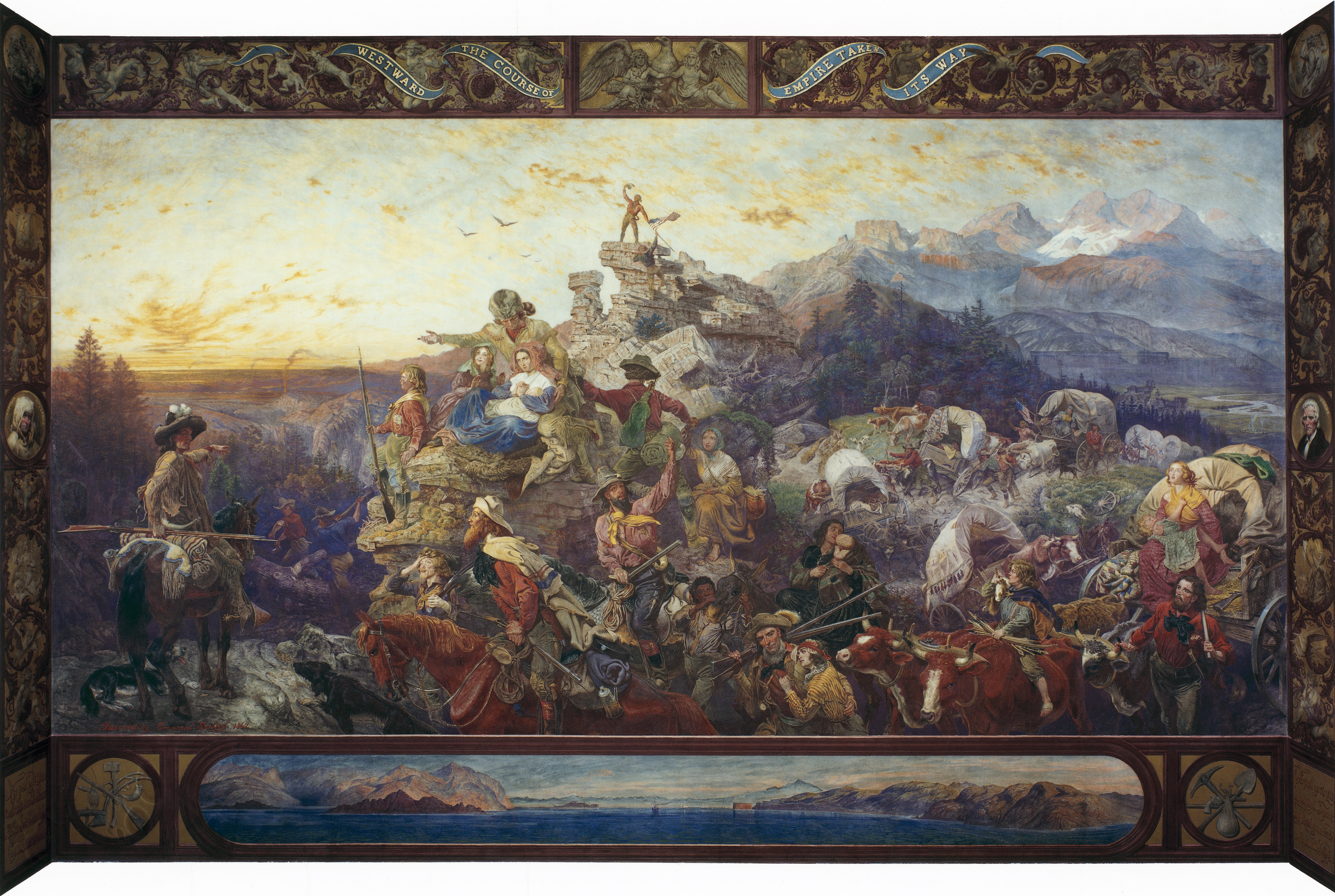
“On the Prospect of Planting Arts and Learning in America.” Emanuel Leutze’s mural celebrates the western expansion of the United States. It is located in the House wing of the US Capitol building, on the west stairway.
Moyers: On reservations.
Whitman: Yes. Now, we want to be very, very careful in interpreting Nazi invocations of the US. Many German historians have remarked on the fact that the Nazis often invoked the American example. It’s hard to miss when you look at the sources. Still, we really must not make this a story of causation in which the Nazis would never have committed the crimes they committed unless they had been able to draw inspiration from the United States. There were too many other sources for the evil crimes of Nazism. One wants to soft-pedal this a little bit. And yet it’s there. That’s what Hitler did say in l928. You can’t read this stuff without shuddering today.
Moyers: So let’s pause there for a moment. You acknowledge in your book that none of this is easy to talk about, that it’s hard to digest the idea that American law might have exerted any sort of direct influence on the Nazi program of racial persecution and oppression. And no one, as you yourself say, wants to imagine that America provided any measure of inspiration for Hitler. So you conclude that it would be wrong to say that the Nazis directly borrowed from the Americans, that this is not a story of an exact transplant from one legal culture to another.
In fact, you tell this story very cautiously, with careful qualifications — the American and Nazi regimes were not the same. But you nonetheless conclude that from Hitler’s Mein Kampf on, the Nazis lionized American white supremacy and rummaged, as you put it, in American immigration and citizen laws. The National Socialist Handbook for Law and Legislation even described America as the country that had achieved a fundamental recognition of the historic racist mission that Nazi Germany was now called to fulfill. And we keep saying you can’t escape this as we go through the history. We cannot escape it.
Whitman: Yes, that’s exactly right. I should say that I didn’t expect to write the book. I didn’t know I would find what I found. The universal view among American historians is that there had been no influence or no meaningful influence of American law on the Nazis. There patently was. I think that we hadn’t understood it, not only because it’s difficult for Americans to talk about it, but more importantly, in some way, it’s difficult for Germans to talk about it. The one thing that you want to avoid, if you want to make an honorable, reputable career in the German academic world, is to say anything that might seem to represent an apologetic for the Nazis or to deny German responsibility for Nazi crimes. That makes it hard for Germans who are really the natural scholars to work through this material to do so. You have to read an awful lot of German material. You have to read a lot of technical law, and you have to have some training in order to do it. And there are a lot of reasons not to want to do it. But boy, when you do start digging, and you find the stuff there, it’s exactly as you say — it’s painful. You mentioned The National Socialist Handbook for Law and Legislation — well, it indeed described the US as the country that had arrived at the fundamental recognition of the need for creating a race state, and then went on to explain that it was now the turn of Nazi Germany to do a more rigorous and efficient job of what the Americans had begun. That’s a characteristically German view of all of this.
Hitler himself, in Mein Kampf, described the US as the one state that had made at least some progress for creating the kind of race order he wanted to create in Germany. In fact, that’s how I started the research. I pulled Mein Kampf off the shelf, saw that phrase, and thought, “Maybe there’s something more here.”
Moyers: Had you started to write this book before then?
Whitman: No, that was how I started.
Moyers: Reading Mein Kampf?
Whitman: Yes. It’s obvious that American and the Jim Crow era had a race-based or racist regime that resembled what emerged in Germany, so the question of whether there was some influence was a natural one, or at least some resemblance. And I thought I’d just take a look to see what I found and once I began looking, I found a lot.
Moyers: You quote the Nazi author of The Supremacy of the White Race, Drascher, who said that were it not for the contribution of the Americans, a conscious unity of the white race would never have emerged. Reading just that sentence, I can feel rumbles from American politics today, and it’s chilling.
Whitman: It sure is. I didn’t expect to produce a book that would be timely in the way this one has turned out to be timely. But over the past year, the continuities in American history seem to have revealed themselves.
Moyers: Let’s go back to these German lawyers and jurists in that meeting on June 5, 1934. Some historians have suggested that at around that time, Germany and the American South had the look of a mirror image. They were both unapologetically racist. At that time, the Jews of Germany were hounded, beaten and sometimes murdered by mobs and by the state alike and in the same years the blacks of the American South were hounded, beaten and sometimes murdered as well. There are parallels so powerful in our mutual histories that you just have to shake your head.
Whitman: Yes, you do. I don’t know what to say. It’s hard for us to digest in the US. There’s a lot that we would prefer to forget. And I will say, not just that we would prefer to forget when it comes to our own history, but that we’d prefer to forget about American influence abroad because our example has not always been one for good in the rest of the world.
Moyers: I watched the mayoral debate on Oct. 10 here in New York City. It was a noisy, raucous affair, and I remembered your writing that the Nazis didn’t like New York City. They saw it as a place where “the representatives of the races” gathered to create “a mishmash of ideas and people,” a place marked by a great influence of the Jews, which made institutions like Columbia University centers of radicalism, and they thought that the true America by contrast was Anglo-Saxon and Protestant.
Whitman: That’s what they said. I’m sure New York was a fun place to visit regardless. Even if you were a Nazi. But it’s true, they regarded the city of New York as just a hotbed of what Hitler called “Jewish elements” and were very, very suspicious of that same brash New York culture you’ve just described in the debate.
Those particular quotes, which were typical, I should say, of the far-right wing in Germany — far-right wingers have been saying things like that about New York for a long time — were from a Nazi book written in praise of Franklin Roosevelt as someone whom the Nazis at first thought exemplified some of the same virtues of their Führer in the early 1930s. That’s another uncomfortable piece of this story.
Moyers: How so?
Whitman: They often described him as a dictator. So did Mussolini, in fact. They thought that New Deal policies, intended of course to address the horrors, or the economic difficulties let’s call them, of the Great Depression, resembled Nazi efforts to do the same thing, which in fact they did. I mean, these were in some ways similar programs, as historians have shown. Some of the Nazi literature at the time said Roosevelt obviously aspired to do the same sorts of things Hitler was doing but who lacked the sort of paramilitary organization, a party army, that was used in Germany to support Hitler’s efforts. This was a pretty widespread impression. The Italian fascists thought similar things of the early New Deal.
So take the first programs of 1933 and 1934 — in particular what was called the National Recovery Administration, eventually struck down by the Supreme Court — when Mussolini was shown the plan for it, he said, “É un dittatore.” “That’s a dictator.” The perception that Roosevelt really was moving in the same direction as Central European dictators was pretty widespread in those countries in the early 1930s. Later on it became clear that it wasn’t the case. But, again — we don’t like to remember it, but especially in the early years of the New Deal, the Roosevelt administration depended very, very heavily on the support of the segregationist South. Roosevelt was very careful not to cross those Southern Democrats and that may also have contributed to the impression in Nazi Germany and elsewhere that there was something kindred in the New Deal regime to what they were doing.
Moyers: There was traffic back and forth between Germans and Americans who promoted eugenics — you know, the sterilization of the mentally defective and the exclusion of immigrants said to be genetically inferior. You quote a German author who declared in 1935, “The Americans have begun to think about the maintenance of race purity and thus to ask not only about eugenics, but also about membership in individual races. It can be seen in their immigration laws, which completely forbid the immigration of yellows” — meaning Asians — “and place immigration from European countries under sharp supervision. The American knows very well who made his land great. He sees that the Nordic blood is drying up and seeks to refresh that blood through his immigration legislation.”
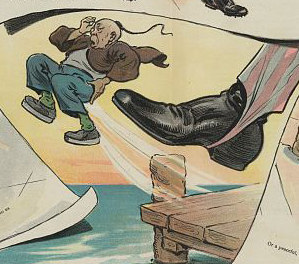
“How John may dodge the exclusion act” by J.S. Pughe. This illustration shows Uncle Sam’s boot kicking a Chinese immigrant off a dock as part of an anti-Chinese immigration campaign. (Image courtesy of the Library of Congress)
Whitman: Yes, the passage you quote is from a Nazi-sympathizing doctor in 1935, saying things that Nazis frequently said at the time. American immigration law had been admired on the European far right wing for a long time, including in particular in a book called The Handbook of the Jewish Question. This was a kind of a minor bible of the Nazi movement, going back to the late 19th century, because already by then the US was restricting immigration in ways that inspired radical Nazis.
And yes, you are absolutely right in saying that eugenics, American eugenic theories played a big role in all of this. Other historians have shown this. American eugenic theories were influential in many parts of the world, not just in Nazi Germany. Eugenic approaches at the time, as difficult as it is for us to imagine now, were respectable. Sweden, for example, was a center of eugenics legislation. So the eugenics business didn’t just involve the Nazis and the US, but it is absolutely true that the Nazis were great admirers of American eugenic theories. There was a lot of back and forth as you say. American eugenicists went to Germany. German eugenicists came to the US. They conferred and discussed and compared notes.
Moyers: So that in the early ’30s, when these Nazi lawyers were engaged in creating a race law founded in part on anti-miscegenation law and race-based immigration, they came looking for foreign models and found some in the US.
Whitman: Yes, and studied them very, very carefully. That’s not only true of anti-miscegenation law. The passage that you just quoted earlier on about American immigration law was the product of a lot of very careful study of that law. They worked hard to learn what was going on in the US. And in particular, as you say, they worked very hard trying to understand or to master American anti-miscegenation law. Thirty American states had anti-miscegenation statutes. These were by no means limited to the American South. They were found all over the country. They didn’t target only blacks. They were also particularly devoted to banning and sometimes criminalizing marriages and sex between Caucasians and Asians, Caucasians and Native Americans — it goes on and on. Anti-miscegenation laws were a national phenomenon. At the meeting on June 5, 1934, the memorandum discussed by the minister of justice was accompanied by a list which detailed the anti-miscegenation provisions found in all 30 of the states that had them. And the law of those states was discussed in detail — I would almost say excruciating detail. They were really looking to see what they could learn from the US.
Moyers: You have a quote from that transcript of this meeting. One Nazi says to the state secretary, “I’m reminded of something an American said to us recently. He explained, ‘We do the same thing you Germans are doing, but why do you have to say it so explicitly in your German laws?’” And the state secretary answered, “But the Americans put it in their own laws even more explicitly.” Was he right?
Whitman: He was. It’s quite a memorable exchange, I have to say.
Moyers: You write that the Nazis were obsessed with the state enforcement of racial and sexual purity. Mixed marriages and mixed sex could lead to imprisonment. They included in the Nuremberg Laws “a blood law,” and you write, “It is with the blood law that we discover the most provocative evidence of direct Nazi engagement with American legal models and the most unsettling signs of direct influence.” Would you elaborate on that?
Whitman: Sure. So again there were two principle Nuremberg Laws apart from the flag law that we mentioned before. The first we usually call the citizenship law — the creation of second-class citizenship for Jews was the object of that law. The second law — what we call “the blood law” — was precisely the law about interracial sex and marriage. When it came to the first, the citizenship law, there was plenty of inspiration the Nazis could find in a general way in the United States. But only in a general way, because although the US had no shortage of legal provisions effectively depriving American blacks of voting rights for example and other pertinences of citizenship, and although the US created a special kind of second-class citizen status for certain populations, notably the Filipinos, Puerto Ricans, Native Americans, those aspects of American law for the most part involved legal subterfuges. You couldn’t actually come into court in the US and say blacks are not citizens because after the Civil War the citizenship of blacks was guaranteed in the US, so you had to find tricks. The Nazis were of course not going to use tricks. They were simply going to say openly that Jews are not citizens. They didn’t have any difficulty saying that at all and for that reason when it came to their citizenship program they weren’t going to borrow directly from the United States.
Matters were very different when it came to banning interracial marriage and sex because, as we just said, American anti-miscegenation statutes were completely unapologetic and open about race-based aims. They said “no sex or marriage” between Caucasians and Africans, as they often called them, or between Caucasians and Mongols — that was a typical term for Asians — and so on and so forth. The Nazis had something from which they did not hesitate to borrow and they studied these laws very, very carefully.
Moyers: You write that the US Supreme Court entertained briefs from southern states whose arguments were indistinguishable from those of the Nazis.
Whitman: They were. The sorts of things the Nazis said, often using terms like mongrelization and bastardization of the population were also often said by Southern racists. It was exactly the same vocabulary.
Moyers: Let me read to you. Here’s a quote from a Maryland statute in 1957 — 1957! — that you include in the book:
All marriages between a white person and a Negro, or between a white person and a person of Negro descent, to the third generation, inclusive, or between a white person and a member of the Malay race or between a Negro and a member of the Malay race, or between a person of Negro descent, to the third generation, inclusive, and a member of the Malay race, or between a person of Negro descent, to the third generation, inclusive, and a member of the Malay race or between a Negro and member of the Malay race, or between a person of Negro descent, to the third generation, inclusive, are forever prohibited and shall be void; and and any person violating the provisions of this section shall be deemed guilty of an infamous crime and be punished by imprisonment in the penitentiary for not less than eighteen months or more than 10 years.
That was Maryland law.
Whitman: Yes, and it wasn’t the only one. Laws of that kind weren’t ruled unconstitutional until 1967 by the Supreme Court in the famous case of Loving v. Virginia. You could find them all over the United States and they were of great interest to the radical Nazis. The idea that racially mixed marriage was somehow objectionable was pretty widespread in the world in the early 20th century. Racism was something you found everywhere. But criminalization of the American kind was something that you just couldn’t find elsewhere, particularly criminalization of such harshness as to threaten 10 years of imprisonment. That was was of tremendous interest to radical Nazis who wanted exactly the same thing for Germany.
Moyers: Some of them talked about how America’s long history of sexual relations between masters and slaves left the US “groaning under the weight of an enormous mass of mongrels.” Which brings us to Sen. Theodore Bilbo from Mississippi, one of the most powerful of all Southern politicians.
Whitman: He figures in my book as he does in some other very important work by Ira Katznelson. Sen. Bilbo was a dyed-in-the-wool racist and a great pillar of the New Deal government in the early 1930s and thereafter. You’re absolutely right — the huge mass of “mongrels” was something the Nazis recognized in the United States. That’s a German phrase, it’s not a Nazi one, but it’s a German phrase for describing the American situation. One of the shocking things about my research was to come to terms with the fact that American definitions of who counted as black or members of other races were much more far-reaching and draconian than anything the Nazis themselves came up with.
Moyers: Bilbo said, “One drop of Negro blood placed in the veins of the purest Caucasian destroys the inventive genius of his mind and palsies his creative faculty.” Is it true that the Nazis thought the one-drop rule too extreme?
Whitman: They did indeed. They never proposed anything nearly as extreme as the one-drop rule. In fact the standard, the most far-reaching Nazi definitions of who counted as a Jew, matched the least far-reaching ones to be found in the American states. Virtually all American definitions of who counted as a black were far more draconian than anything found in any Nazi proposal. At the same time, the Nazi literature expressed real discomfort about the so-called one-drop rule, which, I have to say, was not found in every American state, as there were a variety of approaches in the US. But it was understandably notorious. The Nazis, difficult as it is to imagine, described the one-drop rule as inhuman, as “involving human hardness that’s going much, much too far, you couldn’t do that kind of thing,” they said. And their own definitions for who counted as a Jew, especially those that were ultimately attached to the Nuremberg Laws, were more restricted than anything to be found in American states at the time.
Moyers: Talk about The Cable Act of 1922. I never heard of it until I read your book.
Whitman: The Nazis were interested in it. The Cable Act was the American version of something found throughout the world at the time — certainly in Europe and the United States. The Cable Act dealt with a standard problem in the law of the day. According to traditional legal definitions in the 19th century, a married woman acquired the citizenship of her husband and lost her native citizenship. That was part of the general submersion of a wife’s legal personality into the personality of her husband. That rule was being abrogated everywhere in the early 20th century and it was abrogated in the United States, too, but the Cable Act included an exception. It said, “Although women retain their American citizenship ordinarily when they marry a non-American citizen, if they stoop so low as to marry a Japanese person or an Asian, they have to be deprived of citizenship in that case.”
It’s one of a few examples the Nazi lawyers talk about that I think may have played a role in the formation of the ultimate regulations implementing the Nuremberg Laws. In determining who counted as a Jew, the Nazis decided that anybody with two Jewish grandparents would only count as a Jew if that person practiced the Jewish religion or married another Jew. This idea of who counted as a member of a given race depending on their marital history was something for which we could find a bunch of examples in American law and the examples are discussed in the Nazi literature.
Moyers: The Prussian Memorandum we discussed earlier declared that causing harm to the honor of the race could also be made criminally punishable. When I read your take on this, I thought of the current debate over athletes taking a knee during the Pledge of Allegiance or the national anthem. There are people on the right, including the president of the United States, who say they are dishonoring the flag, dishonoring the history of the country. How little they know of our history. We’re still fighting over legacies from the past.
Whitman: Yes. I handed in the corrected proofs of this book the day before Election Day, so although I knew that some of these undercurrents in America were erupting once again, I didn’t understand how much that was the case. What you say is quite true. Things obviously have improved immeasurably. We’re not back in the 1930s and I wouldn’t want anyone to read my book as suggesting we are. We’re certainly not. There are nevertheless obvious resemblances and obvious continuities. and it’s interesting that you mention the controversy over the national anthem and the flag. It’s worth emphasizing that the swastika flag played a big role in the Nuremberg Laws as well. The Nazis were very, very concerned with demanding obeisance to the symbols of the regime. They even discussed how people might be required to show respect for the heroes of the Nazi movement and of German history; that discussion played a role in that June 5, 1934 meeting. But these kinds of things mattered to them just as they matter now on the American right wing.
Moyers: White supremacists have been emboldened by Trump. There were the storm troopers marching through Charlottesville searching for Jews. The far right gains support over issues such as immigration, identity, nationality, even greatness: “Make America Great Again.” All reverberations from our past.
Whitman: At that Charlottesville rally, people were chanting, “Blut und Boden,” which is “Blood and soil” — that’s the Nazi slogan. Obviously consciously borrowing it from the Nazis and displaying flags that barely alter the swastika symbol. There’s no question that they at least want to trumpet their sense of kinship with the Nazi movement. How much they really know about it, I don’t know. But in researching for this book I learned that it’s not just a matter of Americans borrowing from Nazis; the Nazis were borrowing from the Americans too. A lot of this unfortunately got started in our country.
Moyers: So tell me about Heinrich Krieger. He’s one of the most fascinating personalities to appear in your book.
Whitman: Yes, he was a young Nazi lawyer who somehow in the year 1933–34 found himself an exchange student in Arkansas. He obviously loved international travel. He was particularly interested in indigenous legal traditions so he worked on American Indian law. Published a perfectly good article on American Indian law in an American law review, one that was certainly written from a Nazi point of view but that showed real mastery of the law and said some intelligent things about American Indian law. I hope I don’t offend anybody in observing that there were smart and gifted people who were Nazi lawyers. He returned to Germany where somebody in the justice ministry heard about this kid off in Dusseldorf who knew something about American law. He then wrote a memorandum describing American law and displaying real mastery of American law and American race law. He followed that with a thick book called Race Law and the United States, which is a Nazi book but a Nazi book full of acute observations. You don’t want to say anything good about any Nazi scholars but the truth is that Nazis were able to see things in America, precisely because they were looking at them from a Nazi point of view.
Moyers: His heroes were Thomas Jefferson and Abraham Lincoln. Explain that.
Whitman: Isn’t it hard to take? Well, so it’s important here as background to explain the aims of the early Nazi program. When the Nazis first came to power, the Holocaust was not yet on the horizon. Hitler, as we’ve seen, had spoken of the Americans gunning down the millions of redskins. But despite that, the idea of mass murder wasn’t really practical or much discussed. The early aim of the Nazi program was to force the Jews to emigrate. It was to expel the Jews as had been done in Europe in the Middle Ages or to make life so miserable for them in Germany that they would flee.
Here is the hard part in talking about American history: The reason that Heinrich Krieger admired Jefferson and Lincoln is that both Jefferson and Lincoln repeatedly said that the only real hope for the US lay in resettling the black population somewhere else. And he quoted both Jefferson and Lincoln to that effect. His view of American history was that if only Lincoln hadn’t been assassinated Lincoln would have instituted something like the order the Nazis wanted — that is, he would have found some way to resettle the black population, now freed, in the United States. In particular there was some contemplation of establishing a colony in Central America. He said, “If only Lincoln had survived, then America would be the kind of place that Nazi Germany aimed to be as well.” I tell you, it’s a shock to read these things but that is what he said.
Moyers: He was fond of Jefferson’s declaration in 1821 on the impossibility of racial coexistence: “It is certain that the two races equally free cannot live in the same government.”
Whitman: Yes, that’s just one quote from Jefferson, he said similar things earlier on as well. So you know, they remain our heroes but their world and their mindset were sometimes difficult for us to approve of.
Moyers: In your book you write: “Sometimes the American democratic political process produces admirable legislation but to have a common-law system like that of America is to have a system in which the traditions of the law do indeed have little power to ride herd on the demands of the politicians and when the politics is bad, the law can be very bad indeed.” You go on: “The resulting dangers have not vanished and it would be wrong to close this book without pointing to at least one contemporary realm of American law in which those dangers are still making themselves felt. The realm is American criminal justice. American criminal justice is spectacularly and frighteningly harsh by international standards. It includes practices that are sometimes uncomfortably reminiscent of those introduced by the Nazis.”
What is it that makes contemporary American justice so exceptionally harsh?
Whitman: Oh boy! Certainly one critical answer is the sheer capacity of American politics and politicians to shape American criminal law and American criminal justice. Politicians in the US run on tough on crime platforms. It has to be added as well that both judges and prosecutors are elected officials in much of the US. That’s something unheard of in the rest of the world. And frankly, more humane traditions of the law do very little to stand in the way of translating the demands of politicians into law. In that respect, the situation in the US is really quite different from what we find now in Europe, where professional lawyers, professional criminologists and the like still manage criminal justice. I simply have to say it: the accessibility of the legal system to political influence was exactly what the radical Nazis admired most about America in the 1930s and that’s still doing tremendous damage to our criminal justice system today.
Moyers: Thank you so much, James Whitman.
Learn more about the book at the publisher’s website.

